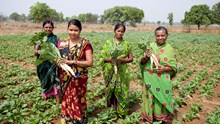
Integrated farming is a sustainable agricultural approach that combines multiple farming activities—such as fish farming, vegetable cultivation, poultry, and goat rearing—on a single plot of land. This holistic model maximizes resource use, minimizes waste, and promotes ecological balance. By interlinking various components, such as using nutrient-rich pond water for irrigation or utilizing animal manure as organic fertilizer, integrated farming enhances productivity, ensures food security, and supports year-round income generation for farmers.

Beginning with Fish Farming
A pond is the central part of an integrated farm. You can start fish farming in case you already have one or are able to dig one on your land. Farmers, in one instance, employed cages that were 4 by 4 by 2 meters in size for rearing fish such as Pangasius, Tilapia, Rohu, and Pearlspot. These are species that are selected for their rapid growth and good market value.
By employing a multiple stocking and multiple harvesting method, farmers introduce new fingerlings every month and harvest the mature fish on a regular basis. This provides a steady supply of fish and frequent cash inflow. Feeding can be controlled by employing a mixture of commercial feed and locally available waste, thereby reducing costs.
Utilizing Pond Bunds for Crops
The earth surrounding the pond or the bunds/dykes should not be left unused. These bunds can be utilized to cultivate seasonal vegetables such as brinjal, tomato, ladyfinger, chilli, and cauliflower. Leafy greens such as fenugreek can also be accommodated. Fruits like mango, banana, papaya, coconut, and dragon fruit can also be planted along the bunds in addition to vegetables.
These crops are supplemented by the nutrient-rich water from the fish pond, minimizing the use of fertilizers and promoting healthy plant growth. The intercropping of short-term vegetable crops and long-term fruit trees provides both immediate and future sources of income.
Adding Poultry for Quick Returns
Introducing a poultry unit to the farm provides an additional income. A small shed constructed of bamboo or tin may be erected next to the pond. Farmers may begin with 200 to 500 birds, either broilers or desi chickens, which mature in 6 to 8 weeks and always have a market. The droppings of the poultry are useful as an input for vegetable farming to enhance soil fertility. Since poultry rearing has a rapid cycle, it offers instant returns and complements income space between fishery and crop harvesting.
Goat Rearing for Additional Profits
Goats are a good fit for small farmers as they are low-maintenance and can survive on farm waste and grazing. They are sheltered by a small, bamboo-made shed raised from the ground, protecting them from water seepage and wild animals. Farmers may begin with Black Bengal, Sirohi, or Osmanabadi breeds, which are renowned for quality meat and rapid growth.
Goats breed fast, and even a small herd of 10 can become 20–25 animals in a year. A healthy goat can earn Rs. 6,000 to Rs. 12,000 in the market, and the manure value is added to the farming system.
Benefits of This Model
This combined model does not leave the farm idle at any time. When one crop or operation fails because of weather or market conditions, the others are still making money. It also minimizes the cost of external inputs since wastage in one unit becomes input for another.
Communities enjoy fresh fish, vegetables, eggs, and meat for their own consumption, while the surplus is sold in the market. By harvesting fish monthly, gathering vegetables weekly, selling poultry every two months, and selling goats annually, farmers would be able to have a consistent flow of money every year.
How Much Can You Earn?
Even a small-scale farmer with half an acre of land can make between Rs. 3 to Rs. 5 lakhs a year if this model is strictly followed. In the successful Gujarat example, a tribal self-help group registered annual incomes of Rs. 14 to Rs. 15 lakhs through integrated farming on community land, proving its effectiveness.
Support and Investment
Establishing such a farm first involves an investment of Rs. 80,000 to Rs. 1.5 lakhs based on the size, including the construction cost of ponds, cages, chicks, fingerlings, sheds, and feed. But the returns begin in 2 to 3 months. Farmers can also approach local Krishi Vigyan Kendras (KVKs), NGOs, and government schemes offering subsidy, materials, and training assistance under tribal development or integrated farming schemes.
Integrated farming offers a route to stable and sustainable lifestyles, not just a method. It enables farmers to make better use of their water and land, lessen their reliance on pesticides, and establish a harmonious agricultural ecology. A brighter future, better food, and more revenue can result from implementing this plan, regardless matter whether you are a tiny landowner or a member of a self-help organization. With commitment and careful planning, a single farm can generate multiple sources of revenue.
















